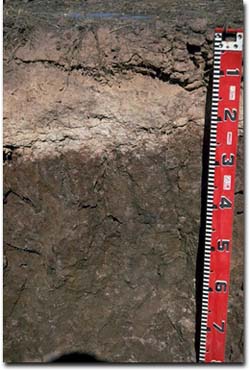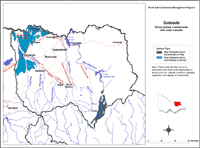Sodosols
Sodosols have a strong texture contrast between the loamy surface (A) horizons and clayey subsurface (B) horizon. The subsoils are sodic (i.e. exchangeable sodium percentage is 6 or greater) and not strongly acid (i.e. pH 5.5 or greater).
Sodosols can be separated on the basis of the upper 20 cm subsoil color, into Red, Brown, Yellow, Grey and Black groups.
Note that other soil types may also occur within these mapped areas (either dominantly or sub-dominantly) depending on factors such as climate, landform, geology, vegetation and degree of weathering. This map will continue to be updated as new information becomes available. Access the Soil and Land Survey Directory from this website to find out about more detailed information from various soil and land surveys that cover parts of this region. |
Sodosols are relatively uncommon in the higher rainfall areas of the North East region, but become more common in the lower rainfall areas to the northwest of the region. They generally occur on the riverine plains to the north and northwest of Wangaratta and are usually Grey or Yellow Sodosols. They have previously been referred to as Grey or Yellow Duplex soils or Solodic soils.
Generalised Description Surface (A) horizons: sandy loam to clay loam texture, usually hard setting, darker surface (A1) horizon overlying bleached subsurface (A2) horizon, weakly structured, clear to abrupt boundary change. Subsoil (B2) horizons: dense, medium to heavy clay, coarse prismatic structure, becomes increasingly alkaline with depth and often more saline. |
 Grey Sodosols near Chiltern. |
References
Rowe, R.K (1967). A Study of the Land in the Victorian Catchment of Lake Hume. Soil Conservation
Authority. Victoria. Technical Communication 5.
Rowe, R.K (1972). A Study of the Land in the Catchment of the Kiewa River. Soil Conservation Authority.
Victoria. Technical Communication 8.
Rowe, R.K (1984). A Study of the Land in the Catchments of the Upper Ovens and King Rivers. Soil
Conservation Authority. Victoria. Technical Communication 16.



